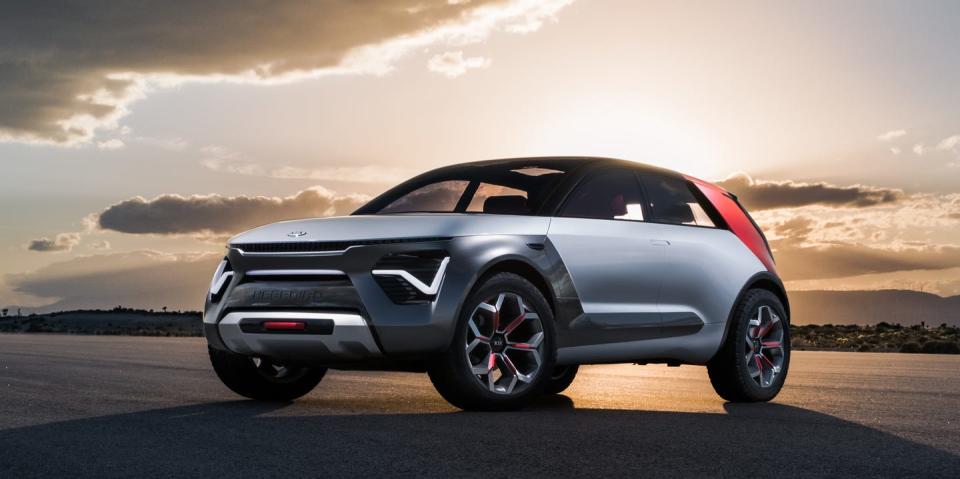The Kia HabaNiro Concept Is an Electric Crossover That Tries to Be Much More

Kia's HabaNiro concept is an electric compact crossover that has been packed full of superlatives.
It replaces Kia's tiger-nose grille with a sharklike front end.
The interior uses AI to change functions according to the driver's mood.
Kia's concept for the New York auto show is called the HabaNiro (we'll spare you Kia's spicy puns), and it's a pretty traditional electric compact crossover-but Kia doesn't want you to think of it that way. It says the HabaNiro "can't be so easily defined," so we're going to let Kia's fairly ridiculous press release do a lot of the talking here. According to them, the HabaNiro is new category of car: an ECEV, or an "all-electric Everything Car" that's a combination of "commuter, crossover, sport-utility, state-of-art technology workroom, and adventure vehicle." Kia also describes it as "a wonder car" and says that it has "more advanced tech than what helped land men on the moon."
At 171 inches long, the HabaNiro is almost identical in length to the regular production Niro. But the HabaNiro is a couple of inches taller, much wider, and rides on a 5.2-inch-longer wheelbase, lending it a much more aggressive stance. The 20-inch wheels on fairly chunky tires and very short overhangs also help the car to "exude coiled muscularity and capability," according to Tom Kearns, the VP of Kia's U.S. design center.
Michael Cole, Kia's COO and executive vice president, called the HabaNiro "a genius work of skill and imagination." The three-tone exterior consists of a Snowdrift White body, a Lava Red "aero panel" on the C-pillar, and satin Granite Grey body cladding; Kia says these elements "create a vibrant energy" and a posture that makes it look "ready to launch." The HabaNiro is the first Kia in recent memory to do away with the brand's signature tiger-nose grille, instead receiving a front end that Kia says resembles a shark's snout. The slit at the top of the front has aluminum "teeth" that are painted black, and Verizon-logo-shaped LED lights are housed in openings off to the sides. Since it's a crossover, there are aluminum skid plates, tow hooks, and other rugged accents. And, Kia emphasizes, the daytime running lights have a "heartbeat pulse" to further press the point on the "animated energy" of this concept.
Each of the HabaNiro's doors open butterfly style to reveal a Lava Red interior that "suggests passion and vibrancy." In place of a bunch of screens, buttons, and knobs, the concept uses a full-width head-up display. This is controlled by a touchpad on a concave acrylic panel with what Kia calls sensory light feedback, and a technical option sharing system that lets the driver and passengers move things across the screen like chess pieces. Light shines through the patterned floor and reflects off interior surfaces, while ambient lighting sets an environmental mood. When Level 5 full autonomy is activated, the steering wheel and instrument panel fold away for more interior space, and movies can be projected onto the windshield.
Your Car Is Watching You
In a bit of a 1984-esque move, the HabaNiro uses Kia's Real-time Emotion Adaptive Driving (R.E.A.D.) system, which uses artificial intelligence and something called "biosignal recognition" to check out the driver's emotional state. This apparently actually works, and it can "alter conditions related to the human senses within the cabin" to create "a more pleasurable and safer driving experience." Whether such a thing would bring pleasure to most drivers, Kia doesn't say.
The R.E.A.D. system's eye tracking tech also allows for a new kind of rearview "mirror." If the driver looks up at the part of the windshield where the rearview mirror would be, the car activates the rear-looking camera and projects its view onto the top of the windshield. Kia says that it has "no immediate plans" to use AI to tell if a driver is hungry and direct them to a drive-through, but that kind of thing would be possible with this new tech. But in slightly more reassuring news, Kia insists it doesn't want AI and autonomy to take the fun out of driving-it should instead enhance it, responding to needs in advance so the driver can focus on, well, driving.
The least outrageous stuff comes when Kia talks about the HabaNiro's powertrain, and that's probably because it is barely mentioned. The concept uses a battery pack of an unknown size, and there's an electric motor at each axle to provide all-wheel drive. Expected range is claimed to be in excess of 300 miles.
Kia acknowledges the assumption that this is just a design exercise but goes on to point out that the Stinger and the Telluride both started off as concepts that weren't intended for production. Kia does say that the HabaNiro's butterfly doors probably won't make it to dealers anytime soon, but with that comes the statement that "The future is an exciting place." We'd have to agree, and all cynicism aside, we think the HabaNiro looks great. If it portends any kind of new design direction for Kia's crossovers, we welcome it-just as long as the over-the-top explanations are kept to a minimum.
('You Might Also Like',)

 Yahoo Autos
Yahoo Autos 